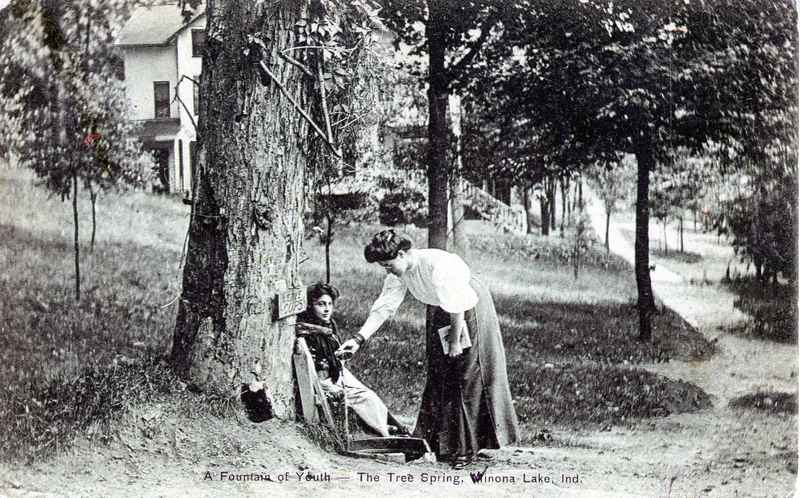True Springs
 Photo credit: Winona History Center
Photo credit: Winona History Center
In the early 1900s, the town of Winona Lake, Indiana, was a summertime destination for many Christians. Cultural Chautauqua speakers and events mixed with a three-week Bible conference in a beautiful lakeside setting to provide a summer vacation for Christians from around the world.
One of the drawing attractions for the visitors was a series of natural springs gushing from the hillside around the lake. The most unique spring was called the Tree Spring. Every day, guests would line up with their metal cups to get the fresh water that gushed from the spring in the middle of a maple tree trunk. The tree spring was reported to have vital minerals that could bring healing to various ailments. But many years later when the tree was cut down, a pipe was exposed running through the ground and up the trunk. The “tree spring” was nothing more than a pipe coming up from a spring that had a tree forced to grow up around it, a man-made imitation meant to attract attention.
I am sometimes reminded of that tree spring as I see ideas and fads that make their way through education. They look refreshing and exciting. It seems that they will provide the answer to all the educational ills. Yet they end up failing because they are based on man-made facades instead of true wisdom and teaching. They will fade away because they are not true representations of Biblical education.
So where can we find the true springs of education? Jesus, who was called Rabbi, Master, or Teacher, gives several examples of educational principles that will never fail. In Mark 12, he says that the greatest commandment is to love God, quoting Deuteronomy 6. This passage in Deuteronomy also tells parents to teach their children God’s principles and always remind them of God’s Word. The first Biblical principle of education is that God’s word is the Truth that will never change; anything taught in schools or at home should be first based on the Bible. So educational trends such as teaching evolution or transgenderism, while they might look as if they are the solution to current problems, will eventually fall through.
A second principle that the Master Teacher Jesus shows is what content to teach his students. He met his audiences where they were, teaching and preaching with parables and stories that they could understand. His lessons met the specific needs of the people to whom he was speaking. Education based on Jesus’ style focuses on what the students will need to know for life on earth and eternity. Current classes (especially in colleges) that focus on unnecessary topics such as contemporary celebrities or entertainment will soon fade in popularity. And in K12 education, time spent unnecessarily on topics such as excessive testing or extensive focus on athletics takes away from the time that could be used to meet the children’s life needs.
Jesus as Rabbi also knew how to relate to His students. He was personable and relational—children wanted to sit on his lap—yet he provided discipline as needed. He called out sin in people and provided a framework of order. Contemporary educational fads that focus on a discipline-free classroom, teachers behaving as students’ friends, or administrators who are afraid to confront a child for misbehavior do not provide their students with boundaries they need to learn to respect authority and ultimately follow Christ. Christian educators should certainly build warm relationships with their students, but also guide them with proper authority and discipline.
So while the educational trends that flow out of modern philosophies look attractive and refreshing, they will not give the “true springs” that students need. A teacher rooted in God’s Word who provides educational content that his students need and leads the students down a disciplined path will make a difference for eternity.
Leave a Reply